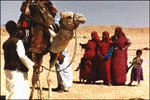|
|
|
This
session will discuss how nomadism can be defined,
characterized and
recognized in the archaeological record of both the
Old World and the
Americas. The participants will explore the relation
of (pre)historic
nomadic populations with their environment and the
settled population,
based on archaeological, historical and/or
ethnoarchaeological sources
(some practical information for the participants can
be found here).
Steve Rosen (Department
of
Archaeology,
Ben-Gurion University, Israel)
will
be discussant during this panel which will be chaired by
Hans Barnard
and
Willeke Wendrich (University
of California, Los Angeles).
|
|
| Willeke
Wendrich (Department
of Near
Eastern Languages and Cultures, University of
California, Los Angeles): Before
we can even begin to broach questions on how to
recognize nomads
archaeologically, on whether nomads have territories and
ownership of
land or resources,
on the relation between the nomadic and the settled
population, on the
social organization of nomadic populations, etcetera, we
will first
have
to define what nomadism is. This paper explores
different approaches
and
discusses the various archaeological and anthropological
definitions of
nomadism in order to clarify the discourse and have a
common ground on
which
to position and discuss the contributions of the
symposium at the SAA
Meeting
and the follow-up seminar in Los Angeles. |
|
| David
Browman (Department
of
Anthropology, Washington University Saint Louis): The vertical ecology,
coupled with
variations in precipitation, and camelids with seasonal
migration
behavioral patterns, made the prehistoric Central Andes
an ideal locale
for pastoral nomadism. Evidence from Central Peru to
Northwest
Argentina is reviewed, summarizing the evidence from as
early as seven
millennia ago, as well as relict nomadic groups that
persisted into the
20th century. |
|
| Hans Barnard
(Cotsen
Institute of Archaeology, University
of California, Los Angeles): Much like
their settled
counterparts,
nomadic people frequently use very distinctive ethnic
markers, cultural
as
well as material. Pottery is not usually associated with
nomads as
elaborate
installations are thought to be necessary for its
production. Proof to
the
contrary has recently come to light, in California and
in Egypt.
Research
on ancient material, as well as experiments on modern,
show that
pottery
must certainly be considered in the study of nomadism. |
|
Reinhard
Bernbeck (Department of Anthropology,
Binghamton
University): Ideas about
the development of nomadism in the Near East depend
heavily on
ethnographies and ethnoarchaeology because of the
assumption that
mobile groups do not
leave enough traces for reliable reconstruction of their
lifeways. I
argue
for a less presentist approach and focus on one aspect
of nomadism,
mobility. Mobility of archaeologically attested groups
must be
accounted for on several scales. In addition to
seasonality,
potentially identifiable through faunal and
palaeobotanical remains,
mid-term mobility must be taken into account. One way to
do so is an
analysis of small-scale stratigraphic events and
their absolute chronological relationships. Such
research may lead to
revisions of 'analogical nomadism' in archaeology.
|
|
| Jeffrey
Brantingham (Department
of Anthropology, University
of
California, Los Angeles) : While the field of
ecology has
witnessed significant advances in both the analysis of
animal movement
and in building models
to predict the effects of movement on population and
community
dynamics,
Paleolithic archaeologists, with a few notable
exceptions, have
contented
themselves with classifying human movement into
residential (forager)
or
logistical (collector) modes. Can this be all there is
to know about
the
organization of human movement in the distant past?
Drawing on null
models
in ecology, a neutral model of forager movement is
developed. The model
is
used to evaluate whether the residential-logistical
mobility continuum
provides
an effective standard for archaeological inquiry. |
|
| Esther
Jacobson-Tepfer (Department of Art
History, University of Oregon): Academic
understandings of economic patterns and belief systems
among the Early
Nomads of late Bronze Age North Asia have hitherto been
based on
mortuary
contexts, Indo-Iranian mythic traditions, and
ethnographic sources. Most
recently, revitalized theories of
prehistoric
shamanism have been applied to petroglyphic imagery from
this period
and
region with far reaching results. This discussion uses
petroglyphic
imagery
from the Altay Mountains of Russia and Mongolia to
challenge these
interpretative
strategies and proposes alternate approaches more
appropriate to the
self-representation of the late Bronze Age Early Nomads
of North Asia. |
|
| Steven
Brandt (Department
of
Anthropology, University of Florida)
and Juris
Zarins (Department
of
Anthropology, Southwest Missouri State University): Traditional
models argue that the origin of Semitic-speaking peoples
that are tied
closely to Mesopotamian cultures that arose following
the original
settlements
of the lower Mesopotamian alluvium, around 5500 BC.
Drawing upon recent
archaeological, linguistic and genetic data, this paper
suggests an
alternative
model in which early Neolithic Afro-Asiatic speaking
nomadic
pastoralists
from Northeastern Africa were the first to introduce
pre-Semitic
languages
and an African form of nomadic pastoralism to Arabia and
the Near East.
Implications of this model for the importance of
pastoral nomadism in
clarifying
issues related to the socio-economic prehistory and
history of these
regions
are discussed. |
|
Benjamin Saidel (W.F. Albright Institute of
Archaeological Research):
Research conducted in the Negev desert has broadly
identified those
areas inhabited by pastoral nomads and agricultural
populations during
the 6th-8th centuries AD. Analysis of archaeological and
textual data
from this area has led to the conclusion that these
pastoral nomads
were integrated into the local economy of the Byzantine
Empire. In this
paper the cooking pots found at pastoral campsites in
this portion of
the Negev are used as a marker to determine how these
economic
relationships impacted the socio-economic organization
of these
pastoral
nomads.
|
|
|
|
|
The
fourth Cotsen Advanced Seminar on
Nomadism is made possible by:
- the Cotsen Institute of Archaeology
at UCLA;
- UCLA Department of Near Eastern
Languages and Cultures;
- UCLA International
Institute, Special Academic
Cooperative Projects;
-
and all individual participants.
|
|

|
Cotsen Institute of
Archaeology at UCLA
P.O.-box 951510; Los Angeles, CA 90095 |
 |
|

